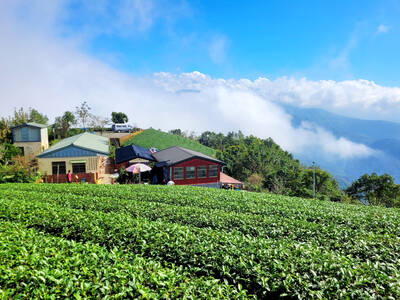In 1869 the First Transcontinental Railroad was finished, connecting the east and west coasts of the US by rail for the first time. The final spike was driven into the juncture of the Central Pacific and Union Pacific lines at a ceremony in Promontory Summit, Utah. A famous photo taken that day captures railroad executives surrounded by a host of workers. But there is a notable absence. The faces of the Chinese laborers who constituted the majority of the workforce of the Central Pacific Railroad’s line that snaked east from California are missing.
The contribution of Chinese immigrants to the creation of the First Transcontinental Railroad is still overlooked, even by the Chinese-American community, says Taiwanese-American photographer Shen-chih Cheng (鄭森池).
“Just about a couple weeks ago, California state officially issued an apology to all Chinese about the anti-Chinese movement,” wrote Cheng in an e-mail from Los Angeles, referring to discriminatory laws in place from the 1870s to the 1940s. “But there were few reactions in the Chinese community here. I really don’t know why that happened.”
Cheng’s exhibition, Walking the Grade (覓金山鴻爪), is on display at the Kuandu Museum of Fine Arts (關渡美術館) until Sept. 20. It captures historic sites connected to the Chinese immigrants who worked on the Central Pacific Railroad. The laborers themselves may be long gone, but Cheng’s lush, highly evocative black-and-white prints give life to their campsites and the original 19th-century railroad grades they painstakingly worked on.
The eight photographs in Walking the Grade are all silver gelatin prints, a photographic process that was invented in the late 1800s and lends Cheng’s work an eerie, timeless quality. Highlights include a photo of an old tent frame from a Chinese railroad workers’ campsite in the Nevada desert; another is of ghost town Lucin, Utah, taken from the distance with clouds hovering in the sky.
Cheng conducted an immense amount of research during the three years he spent tracing the footsteps of Chinese laborers, which included locating sites along the First Transcontinental Railroad with railroad historian G.J. “Chris” Graves. As many as 12,000 Chinese laborers, most from southern China, worked on the Central Pacific Railroad. Many had been lured to California by the gold rush but racist laws and regulations prevented them from mining once they arrived.
Railroad executives were originally dubious about hiring the immigrants, who they deemed physically too small to perform arduous manual labor, but Charles Crocker, one of the presidents of Central Pacific, dismissed their concerns. “The Chinese made the Great Wall, didn’t they?” he said.
Researching the railroad gave Cheng a chance to trace not just the footsteps of the Chinese laborers, but also those of the photographers who preceded him in capturing the First Transcontinental Railroad. His favorite photo in the exhibit is Cape Horn Looking East, which was taken in the Sierra Nevada mountain range. While the railroad was being built, photographer Alfred A. Hart climbed on top of a steam engine to take a photo of the train as it made its way along Cape Horn and the American River gorge.
“There is a legendary story behind [the photo] and I finally made it to the place. The scenery was pretty after heavy rain. Finally, I stood in the same spot as official Central Pacific Railroad photographer Alfred Hart did some 140 years ago,” says Cheng.
Following the historic path of the First Transcontinental Railroad is just one part of a larger project to document sites connected to the history of the Chinese in California. The idea originated in 1980, when Cheng was working in San Francisco. His then-girlfriend, now his wife, was living in Sacramento, the capital city of California, and every weekend Cheng would travel north to meet her.
“We visited some places in the Sacramento area, specifically the gold rush-era sites, and learned that they all have Chinese involvement,” says Cheng. One of the sites that caught Cheng’s attention during the couple’s day trips was Locke, a small town that was built by Chinese merchants for themselves in 1915 and retains many of its original buildings.
“I liked this town so much. Its photographic and historical texture really attracted me deeply. I started to photograph [Locke] and thought to go beyond and do more old Chinese sites,” says Cheng. He put aside the idea to focus on work and family obligations, but picked it up again in 2005, when he was back in the area visiting his wife’s ailing father. After his father-in-law passed away, Cheng made the decision to start photographing historic sites connected to Chinese immigrants at every opportunity he got. Walking the Grade was born out of the project, which Cheng says he expects to spend the rest of his life on.
“When I started 29 years ago, there was not much information to gather but a few books. Now, through the Internet, I have too much information. There are always too many places and too little time,” says Cheng.

In recent weeks the Trump Administration has been demanding that Taiwan transfer half of its chip manufacturing to the US. In an interview with NewsNation, US Secretary of Commerce Howard Lutnick said that the US would need 50 percent of domestic chip production to protect Taiwan. He stated, discussing Taiwan’s chip production: “My argument to them was, well, if you have 95 percent, how am I gonna get it to protect you? You’re going to put it on a plane? You’re going to put it on a boat?” The stench of the Trump Administration’s mafia-style notions of “protection” was strong

Every now and then, it’s nice to just point somewhere on a map and head out with no plan. In Taiwan, where convenience reigns, food options are plentiful and people are generally friendly and helpful, this type of trip is that much easier to pull off. One day last November, a spur-of-the-moment day hike in the hills of Chiayi County turned into a surprisingly memorable experience that impressed on me once again how fortunate we all are to call this island home. The scenery I walked through that day — a mix of forest and farms reaching up into the clouds

With one week left until election day, the drama is high in the race for the Chinese Nationalist Party (KMT) chair. The race is still potentially wide open between the three frontrunners. The most accurate poll is done by Apollo Survey & Research Co (艾普羅民調公司), which was conducted a week and a half ago with two-thirds of the respondents party members, who are the only ones eligible to vote. For details on the candidates, check the Oct. 4 edition of this column, “A look at the KMT chair candidates” on page 12. The popular frontrunner was 56-year-old Cheng Li-wun (鄭麗文)

Oct. 13 to Oct. 19 When ordered to resign from her teaching position in June 1928 due to her husband’s anti-colonial activities, Lin Shih-hao (林氏好) refused to back down. The next day, she still showed up at Tainan Second Preschool, where she was warned that she would be fired if she didn’t comply. Lin continued to ignore the orders and was eventually let go without severance — even losing her pay for that month. Rather than despairing, she found a non-government job and even joined her husband Lu Ping-ting’s (盧丙丁) non-violent resistance and labor rights movements. When the government’s 1931 crackdown